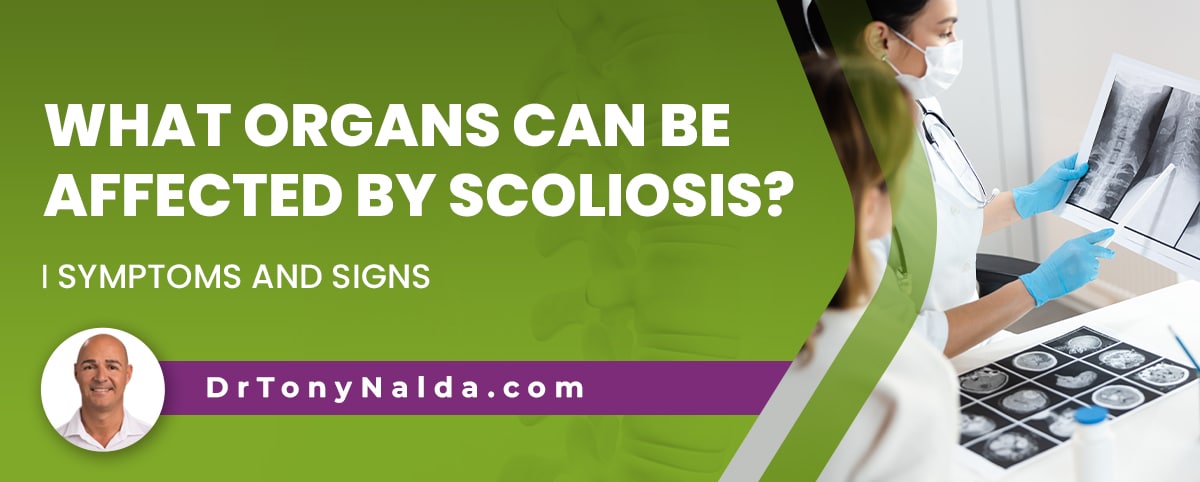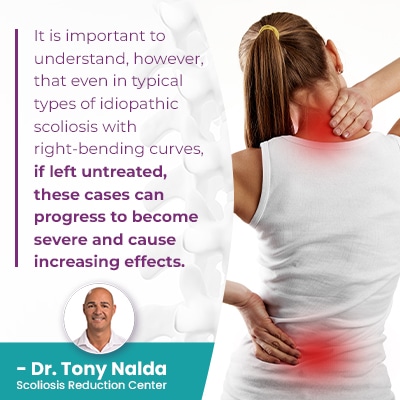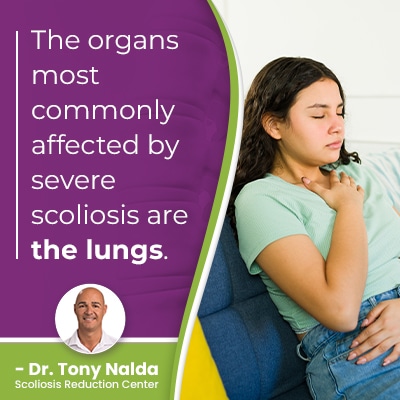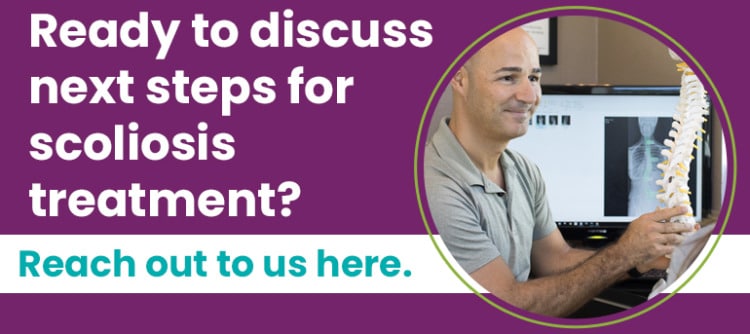What Organs Can Be Affected by Scoliosis? Symptoms and Signs

There are typical and atypical types of scoliosis, and when it comes to severe symptoms and/or organ involvement, the lungs are most often affected. The most common effect of childhood scoliosis involves postural changes and the most common symptom of adult scoliosis is pain.
When it comes to living with scoliosis, each case is unique. There are different severity levels, types, and curvature types/locations that shape a condition's effects. Organ complications aren't considered a common symptom of scoliosis, but in severe and/or atypical types, lung function can be disrupted.
It's important for patients recently diagnosed to understand that as a progressive condition, where a scoliosis is at the time of diagnosis doesn't mean that's where it will stay.
Table of Contents
Typical vs Atypical Types of Scoliosis
When scoliosis is first diagnosed, conditions are comprehensively assessed so they can be further classified based on key patient/condition variables.
Classifying conditions is about streamlining the treatment process and shaping the customization of treatment plans.
Conditions are classified based on patient age, curvature location, condition severity, and type; these are important factors not only because they can indicate the types of symptoms of scoliosis a patient is likely to experience, but also because they predict certain treatment needs.
The most common type of scoliosis overall is idiopathic scoliosis.
Idiopathic Scoliosis
Idiopathic scoliosis accounts for approximately 80 percent of known diagnosed cases of scoliosis, and the remaining 20 percent are considered atypical and are associated with known causes.
Idiopathic means not clearly associated with a single known cause, so in the vast majority of scoliosis cases, we don't know what triggers their initial onset, but we do know it's growth that triggers progression.
So childhood scoliosis always needs to be taken seriously because conditions can progress quickly as a child grows.
Scoliosis causes the spine to bend unnaturally to the side and rotate, making it a complex 3-dimensional condition, and in typical cases of idiopathic scoliosis, curves will bend to the right, away from the heart, but in atypical cases of scoliosis, curves can bend to the left, towards the heart; these are the cases that most often affect organs.
Scoliosis with Known Causes
 Scoliosis with known causes involves atypical condition types, and this includes neuromuscular scoliosis, degenerative scoliosis, and congenital scoliosis.
Scoliosis with known causes involves atypical condition types, and this includes neuromuscular scoliosis, degenerative scoliosis, and congenital scoliosis.
These types of scoliosis often feature left-bending curves, and when the spine bends and twists unnaturally towards the heart, a number of unique effects can develop that aren't a common part of typical cases.
Scoliosis ranges from mild scoliosis to moderate scoliosis, severe, and very severe scoliosis, and atypical types tend to be more severe and progress faster.
It is important to understand, however, that even in typical types of idiopathic scoliosis with right-bending curves, if left untreated, these cases can progress to become severe and cause increasing effects.
The organs most commonly affected by severe scoliosis are the lungs.
Lung Impairment
Neuromuscular scoliosis is caused by the presence of a larger neuromuscular condition such as spina bifida, muscular dystrophy, and cerebral palsy.
Neuromuscular conditions cause a disconnect between the brain, the spine, muscles and/or connective tissues and ligaments that support the spine; as these cases are atypical, particularly severe, and can feature left-bending curves, lung function can be disrupted.
There are two lungs, one on each side of the heart: one on the right side of the body and one on the left.
The lung on the left is slightly smaller than the right lung because it has to allow space for the heart and even has a small cardiac notch: an indentation that accommodates the heart.
The lungs are the respiratory system's primary organs, and their roles are gas exchange, bringing oxygen into the body and bloodstream, and removing carbon dioxide from the body.
What's interesting about scoliosis-related lung impairment is that even when it's part of severe scoliosis, difficulty breathing isn't always noticeable, and in most cases, lung impairment and changes to lung volume are only noticed by professional athletes who place higher-than-average demands on their respiratory systems.
Thoracic Scoliosis and Lung Impairment
Curvature location is another key factor conditions are classified around, and scoliosis can develop in any of the spine's three main sections: the cervical spine (neck), thoracic spine (middle/upper back), and the lumbar spine (lower back).
The thoracic spine is the largest spinal section, and when it comes to reduced lung capacity as a condition effect, this is most closely associated with thoracic scoliosis.
The thoracic spine is the only section that attaches to the rib cage, and as an unnatural spinal curve in the thoracic spine bends and twists unnaturally, it can disrupt the position of the attached rib cage, causing the development of an arch where one side of the rib cage protrudes more than the other.
When this occurs, and particularly when the curve is bending to the left, this can cause compression of the chest cavity and the lungs within: meaning less space for the lungs to function optimally within.
If the lungs are being exposed to uneven pressure (compression), difficulty breathing can include being unable to inhale and exhale deeply.
Cardiac Issues
When the lungs are being compressed, this can also affect the heart; if the left lung is being compressed and pushed more into the heart, cardiac issues that affect the heart's ability to pump blood, although rare, can also develop.
Digestive Issues
The digestive system can also be affected in severe and/or atypical cases of scoliosis by compressing the stomach and intestines, and this can cause issues with digestion, absorbing nutrients, heartburn, abdominal discomfort, and acid reflux.
While there are never treatment guarantees, particularly when diagnosed early and treated proactively, scoliosis can be highly treatable, and many of the condition's potential effects can be minimized and/or avoided completely.
The Power of Proactive Scoliosis Treatment
 It's scary discussing the potential complications and effects of scoliosis that's severe, atypical, and/or is left untreated, but the reality is that scoliosis can be highly treatable, and the types of scoliosis most capable of affecting organs aren't typical condition types.
It's scary discussing the potential complications and effects of scoliosis that's severe, atypical, and/or is left untreated, but the reality is that scoliosis can be highly treatable, and the types of scoliosis most capable of affecting organs aren't typical condition types.
As a progressive condition, the best time to start treatment is always now, particularly in children who are more at risk for rapid-phase progression due to growth spurts.
With early detection, a proactive treatment plan can work towards preventing progression and everything that comes with it: increasing curve size, condition effects, and potentially leading to complications such as organ issues.
There are three ways to respond to a scoliosis diagnosis: with traditional treatment, modern conservative treatment, or leaving it untreated.
Traditional Scoliosis Treatment
Traditional treatment isn't proactive and doesn't have a strategy for addressing scoliosis while mild, which is precisely when treatment should be started as conditions are at their mildest, are the simplest to treat, and the spines are still flexible and responsive.
Traditional treatment will do little to prevent progression, but commonly recommends spinal fusion surgery when/if conditions become severe; surgical treatment is invasive and can cost the spine in terms of its long-term health and function.
Conservative Treatment
Modern conservative treatment is proactive; its main goal is to prevent scoliosis effects from getting worse alongside progression, and helping patients avoid the need for invasive spinal surgery.
Conservative treatment is started as close to the time of diagnosis as possible and combines multiple scoliosis-specific treatment disciplines to impact conditions on every level.
Untreated Scoliosis
Scoliosis that's left untreated is virtually guaranteed to get worse over time, and the longer scoliosis is left untreated and the more it progresses, the more complex it will be to treat, the more overt its effects will be, and the more likely it is that complications such as cardiac issues and lung impairment can develop.
Conclusion
Scoliosis can be highly treatable, and many cases of scoliosis don't need surgical treatment.
When it comes to typical cases of idiopathic scoliosis, the most common effects involve postural changes such as uneven shoulders, uneven hips, muscle weakness, muscular imbalances, and pain; when it comes to atypical cases, atypical effects, and potential complications, these can include breathing problems, cardiac and digestive system issues.
So while organs aren't commonly affected by scoliosis, particularly in typical cases that are being treated proactively, the lungs, heart, and organs of the digestive system can be affected when cases are severe, atypical, or are left untreated.
Here at the Scoliosis Reduction Center®, my patients benefit from a modern conservative proactive treatment approach that combines the power of chiropractic care to reduce curves, physical therapy to strengthen core muscles for more spinal support, corrective bracing, and rehabilitation.
The effects and potential complications of scoliosis can be minimized with proper treatment, and as a progressive condition, the timing of when that treatment is started is a key factor.
Dr. Tony Nalda
DOCTOR OF CHIROPRACTIC
After receiving an undergraduate degree in psychology and his Doctorate of Chiropractic from Life University, Dr. Nalda settled in Celebration, Florida and proceeded to build one of Central Florida’s most successful chiropractic clinics.
His experience with patients suffering from scoliosis, and the confusion and frustration they faced, led him to seek a specialty in scoliosis care. In 2006 he completed his Intensive Care Certification from CLEAR Institute, a leading scoliosis educational and certification center.
About Dr. Tony Nalda
 Ready to explore scoliosis treatment? Contact Us Now
Ready to explore scoliosis treatment? Contact Us Now





